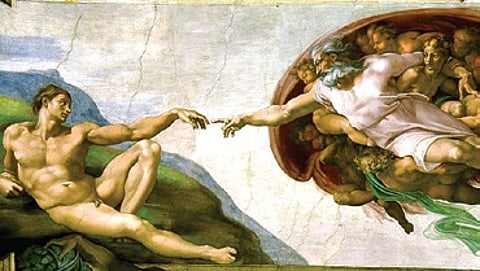

“Oh my God, how much struggle he must have gone through to create it”
This was my reaction when I stood at the Sistine Chapel of the Vatican in the eighties and looked at the great creation of Michelangelo on its ceiling ‘The genesis’. Though I read and saw reproductions of it countless times, this was the first time I was actually seeing it. The enormous visual dimension and the aesthetic quality of this world famous work of art can’t be described in words. Created by one of the geniuses, this work is perhaps the most important creation in the Renaissance era. ‘The genesis’ depicted in nine important segments that is surrounded by other figures —this mural tells the story of human birth and the universe as per the Old Testament. The separation of light and darkness; the creation of sun, moon and earth; the separation of land and water; the creation of Adam; the creation of Eve; the temptation and expulsion; the sacrifice of Noah; the great flood; and the drunkenness of Noah are true master pieces.
But the most important and greatly acclaimed rendering among these is the ‘Creation of Adam’ depicting the man in nude as created by God. The God, in the process of the creation, is pointing his finger at the man’s fingers that is separated by a mythical distance and is celebrated in art. Whether it shows the nearness of God and man or the separation is not known. Recently, researchers on this great work claimed that Michelangelo has used the golden ratio rule in this work. Golden ratio is the division of a space with 1.6 so that it creates a compositional proportion. It is a theory actually derived from observing certain works of artistic importance over the time.
It is the imagination and creative ability of an artist that results in a work that can be termed like this, not the application of any theory. No serious creative person uses theories to control his imagination and creative ability. He uses his visualisation and aesthetic understanding to arrive at certain level and quality in a work.
While writing this, I am sitting in front of a painting by M F Husain. It is of a man sitting on a bench holding a folded umbrella; there are umbrellas in the back ground too. This is one of the finest works of the maestro in my collection. I do not think, specially knowing his creative frenzy and speed to work, he was calculating the golden ratio at the time of its creation.
While researchers and art critics are very fond of theorising artistic creations, it is the artistic ability that results in great work of art.
While Vincent van Gogh painted his sunflowers which are a visual feast to our eyes and fulfilling to aesthetic appetite, it is impossible to imagine he sat and calculated the various ratios supposed to be governing the aesthetic dimensions.
It is a human tendency to look at anything that has already been created and theorise its various aspects. This tendency goes back to time immemorial.
While artists spend sleepless nights over their creation and go through great pain in arriving at certain sensibilities and visual dimensions in a work of art, I don’t think it is not very difficult to an armchair theoretician or art critic to evaluate a creation’s success or failure. Ultimately it is the work and its aesthetic appeal that speaks to a connoisseur, not the theories perpetuated about it.
While it is true that there are plenty of mediocre creations, the great works of art don’t need the support of theories. But the theoreticians need great works of art like Michelangelo’s ‘Creation of Adam’ to support their existence.
yusufarakkal1@gmail.com